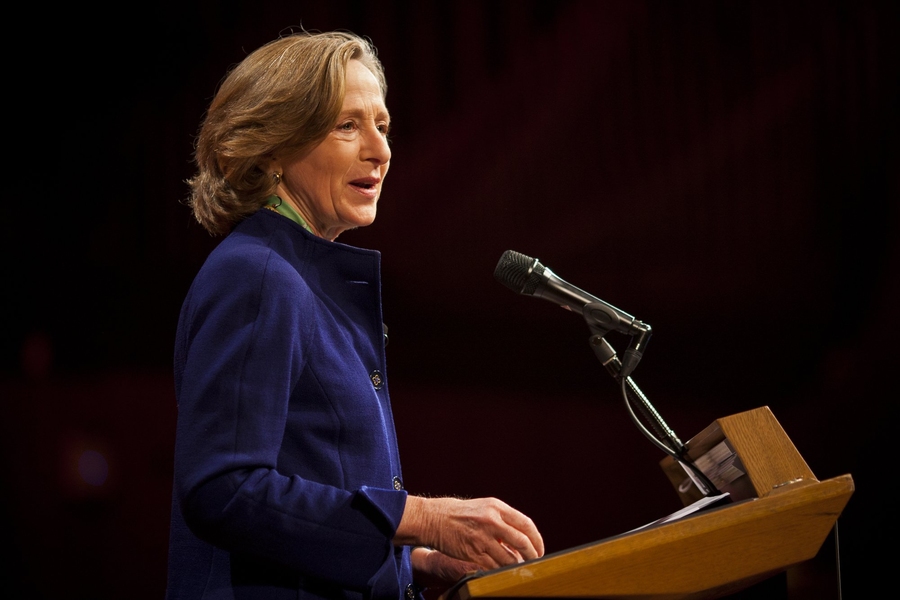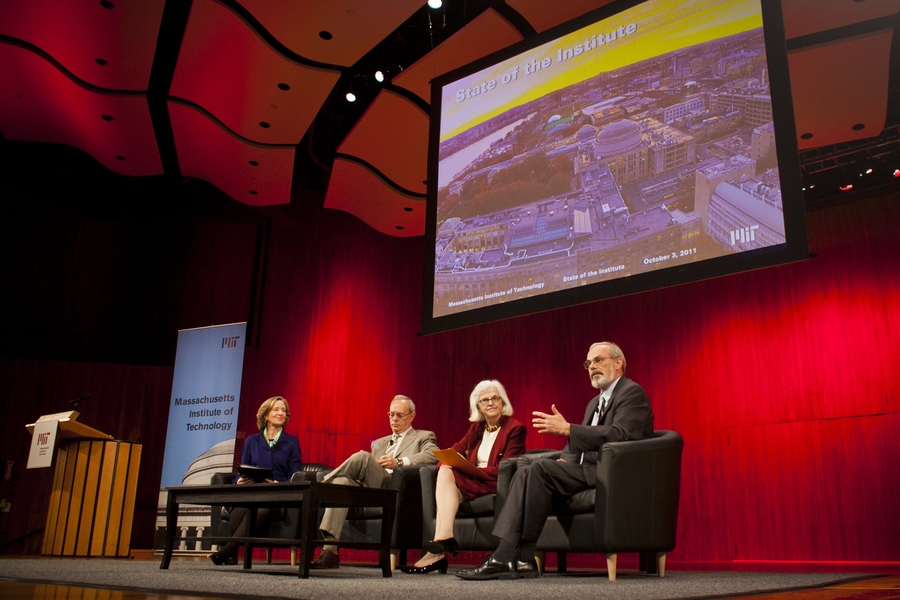At times of uncertainty, “the natural response … is to pull the bridge up over the moat and lock all the gates,” MIT President Susan Hockfield said Monday, as she addressed the MIT community at the annual State of the Institute forum in Kresge Auditorium.
While that instinct may be understandable given the world’s economic and political instabilities, Hockfield stressed the importance of looking beyond the current climate in planning MIT’s long-term growth. Her remarks were upbeat, an optimism shared by Provost L. Rafael Reif, Chancellor Eric L. Grimson, and Executive Vice President and Treasurer Theresa M. Stone, all of whom said that the Institute’s actions from 2008 on have put it in a strong position moving forward.
“We find ourselves in another deeply unsettled time,” Hockfield said. “We’ve adopted a watchful and prudent approach to MIT’s finances that I think is appropriate. But it’s also important that we retain our focus on the very long view, and prepare MIT for the future in many ways.”
In an hourlong forum focused on MIT’s road ahead, Hockfield started off the forum with a look back at MIT’s founder, observing that William Barton Rogers conceived of the Institute as an innovative engine to accelerate American industrialization. She also noted the long-term vision shared by MIT’s sixth president, Richard Cockburn Maclaurin, and philanthropist-entrepreneur George Eastman. With the financial help of Eastman — who at the time was known only as an anonymous “Mr. Smith” — Maclaurin made the decision to move the MIT campus from Boston’s Back Bay to Cambridge, a new home Hockfield cited as a “monument to the American technological century that was about to unfold.”
In describing MIT’s financial state, Reif harkened back to 2005, a period in which the Institute faced a $50 million structural deficit. Reif said it took a couple of years of hard work to turn the deficit around. Today, Reif said, MIT’s finances are “in good stead.”
“There are clouds on the horizon again, but we are on a solid financial foundation,” Reif said.
Looking ahead, Hockfield outlined four major areas in which MIT is focused on the long view: exploring digital learning technologies, contributing to the region’s innovation cluster, promoting advanced manufacturing in the national interest and fostering excellence in the MIT community. In this last category, Hockfield made mention of faculty achievements over the last year, as well as student accomplishments, noting that 14 percent of this year’s incoming freshmen are the first in their family to attend college, and 90 percent ranked among the top 5 percent of their high school class. She cited one member of the Class of 2015 who chose to enroll at MIT rather than accept a Thiel Fellowship — a $100,000 offer to young entrepreneurs that typically leads to their dropping out of college.
Hockfield remarked on the newly renovated Maseeh Hall, noting that the refurbished dormitory has opened up 462 beds — and enrollment spots — for the undergraduate community. While that will require a reshuffling of resources to accommodate increased enrollment and growing class sizes, Grimson said, “opening Maseeh Hall lets us … train more scientists and engineers. We’ll be fine as we ramp up to full pace.”
Grimson championed the residence-based education model, remarking that graduates speak especially fondly of the high-charged environment they experienced as students here. On the other hand, more and more students are taking advantage of online resources, and Grimson is working with deans at MIT to “articulate the classroom of the future” and examine the ways technology can allow greater flexibility for students, especially as they study abroad.
“More of our students are wired and connected,” Grimson said. “We have to take advantage of that, while preserving that essential MIT experience.”
Stone spoke about MIT’s real estate ventures, noting that the Institute’s footprint has grown over the last 60 years. As part of the MIT 2030 plan, she said, MIT is now licensing space to several companies, including Pfizer, and is looking for more opportunities to integrate the campus into the Kendall Square “innovation cluster,” a neighborhood that Hockfield observed has more biotech and information-technology firms per square mile than any other place in the world.
Hockfield spoke of MIT’s plans to examine advanced manufacturing through a faculty-led project called “Production in the Innovation Economy.” The president herself will also look at the role of advanced manufacturing on a national level, as the co-chair of the U.S. Advanced Manufacturing Partnership.
“All of these areas of building for our future require looking beyond current economic uncertainty to chart a viable and robust course for MIT,” Hockfield said.
While that instinct may be understandable given the world’s economic and political instabilities, Hockfield stressed the importance of looking beyond the current climate in planning MIT’s long-term growth. Her remarks were upbeat, an optimism shared by Provost L. Rafael Reif, Chancellor Eric L. Grimson, and Executive Vice President and Treasurer Theresa M. Stone, all of whom said that the Institute’s actions from 2008 on have put it in a strong position moving forward.
“We find ourselves in another deeply unsettled time,” Hockfield said. “We’ve adopted a watchful and prudent approach to MIT’s finances that I think is appropriate. But it’s also important that we retain our focus on the very long view, and prepare MIT for the future in many ways.”
In an hourlong forum focused on MIT’s road ahead, Hockfield started off the forum with a look back at MIT’s founder, observing that William Barton Rogers conceived of the Institute as an innovative engine to accelerate American industrialization. She also noted the long-term vision shared by MIT’s sixth president, Richard Cockburn Maclaurin, and philanthropist-entrepreneur George Eastman. With the financial help of Eastman — who at the time was known only as an anonymous “Mr. Smith” — Maclaurin made the decision to move the MIT campus from Boston’s Back Bay to Cambridge, a new home Hockfield cited as a “monument to the American technological century that was about to unfold.”
In describing MIT’s financial state, Reif harkened back to 2005, a period in which the Institute faced a $50 million structural deficit. Reif said it took a couple of years of hard work to turn the deficit around. Today, Reif said, MIT’s finances are “in good stead.”
“There are clouds on the horizon again, but we are on a solid financial foundation,” Reif said.
Looking ahead, Hockfield outlined four major areas in which MIT is focused on the long view: exploring digital learning technologies, contributing to the region’s innovation cluster, promoting advanced manufacturing in the national interest and fostering excellence in the MIT community. In this last category, Hockfield made mention of faculty achievements over the last year, as well as student accomplishments, noting that 14 percent of this year’s incoming freshmen are the first in their family to attend college, and 90 percent ranked among the top 5 percent of their high school class. She cited one member of the Class of 2015 who chose to enroll at MIT rather than accept a Thiel Fellowship — a $100,000 offer to young entrepreneurs that typically leads to their dropping out of college.
Hockfield remarked on the newly renovated Maseeh Hall, noting that the refurbished dormitory has opened up 462 beds — and enrollment spots — for the undergraduate community. While that will require a reshuffling of resources to accommodate increased enrollment and growing class sizes, Grimson said, “opening Maseeh Hall lets us … train more scientists and engineers. We’ll be fine as we ramp up to full pace.”
Grimson championed the residence-based education model, remarking that graduates speak especially fondly of the high-charged environment they experienced as students here. On the other hand, more and more students are taking advantage of online resources, and Grimson is working with deans at MIT to “articulate the classroom of the future” and examine the ways technology can allow greater flexibility for students, especially as they study abroad.
“More of our students are wired and connected,” Grimson said. “We have to take advantage of that, while preserving that essential MIT experience.”
Stone spoke about MIT’s real estate ventures, noting that the Institute’s footprint has grown over the last 60 years. As part of the MIT 2030 plan, she said, MIT is now licensing space to several companies, including Pfizer, and is looking for more opportunities to integrate the campus into the Kendall Square “innovation cluster,” a neighborhood that Hockfield observed has more biotech and information-technology firms per square mile than any other place in the world.
Hockfield spoke of MIT’s plans to examine advanced manufacturing through a faculty-led project called “Production in the Innovation Economy.” The president herself will also look at the role of advanced manufacturing on a national level, as the co-chair of the U.S. Advanced Manufacturing Partnership.
“All of these areas of building for our future require looking beyond current economic uncertainty to chart a viable and robust course for MIT,” Hockfield said.







